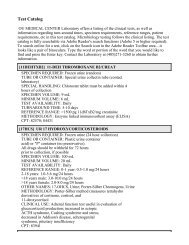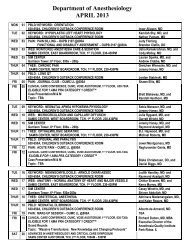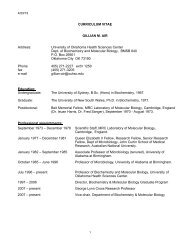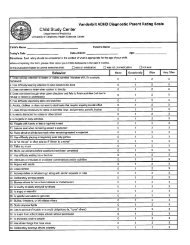THE DILATED URETER - OU Medicine
THE DILATED URETER - OU Medicine
THE DILATED URETER - OU Medicine
You also want an ePaper? Increase the reach of your titles
YUMPU automatically turns print PDFs into web optimized ePapers that Google loves.
ias. 7,9,10 Nevertheless, these studies<br />
document a shift from the traditional<br />
approach of surgical management to<br />
the current trend of surveillance.<br />
Between 1981 and 1987, Keating<br />
and colleagues assessed 44 renal units<br />
in 35 neonates with primary obstructed<br />
megaureter. 7 Infants with ureters<br />
dilated down to the UVJ with varying<br />
degrees of hydronephrosis were included<br />
in the study. Infants with secondary<br />
obstructed megaureters were<br />
eliminated from the analysis. Antenatal<br />
diagnosis was made by US in 23 of<br />
44 units. Of the 23 units, 87% were<br />
managed nonoperatively. Diagnoses<br />
for the remaining 21 units were made<br />
on the basis of symptomatic complaints<br />
due to UTI or the presence of a<br />
flank mass, or they were incidentally<br />
discovered. Only 12 of the 21 symptomatic<br />
units were managed conservatively.<br />
Subsequently, surgery was performed<br />
on 2 of the 12 conservatively<br />
managed units because of increased<br />
obstruction on DTPA diuresis renogram<br />
and increased dilation on US.<br />
The authors suggested that a decision<br />
to manage asymptomatic patients<br />
conservatively should be based on an<br />
estimate of absolute renal function as<br />
determined by diuresis renography. 7<br />
In 1994, Baskin and associates 9<br />
provided a long-term follow up of Keating and colleagues’<br />
7 carefully selected group and found that 10 of<br />
the original 35 neonates with 44 renal units ultimately<br />
underwent surgery. The remaining 25 were observed<br />
and managed with serial urinary tract imaging using<br />
DTPA diuresis renography, intravenous pyelography<br />
(IVP), and/or renal US. Seventeen of the 25 were diagnosed<br />
antenatally, 2 were identified due to infection,<br />
and 6 incidentally diagnosed. Mean follow-up was 7.3<br />
years for 24 patients. One patient was lost to follow-up<br />
after 1.5 years. The conservatively managed patients<br />
demonstrated no decline of renal function on DTPA<br />
diuresis renography during the observation period.<br />
The authors concluded that conservatively managed<br />
patients should be monitored closely as indications for<br />
surgical repair may arise. 9<br />
McLellan and co-workers evaluated the records of<br />
54 newborns who were prenatally diagnosed with primary<br />
obstructed megaureter from 1993 to 1998. 10 Me-<br />
FIGURE 1<br />
Initial radiographic evaluation of suspected urologic<br />
abnormality<br />
Reflux<br />
Vesicoureteral<br />
reflux<br />
SUSPECTED UROLOGIC ABNORMALITY<br />
(prenatal US or symptoms)<br />
US shows dilation<br />
Perform VCUG<br />
Obstructed<br />
megaureter<br />
dian follow-up was 25.8 months. A total of 69 units<br />
were confirmed postnatally using various imaging<br />
modalities. Antibiotic prophylaxis was continued until<br />
the children were between the ages of 9 and 12 months,<br />
depending on physician’s preference. No child had a<br />
culture-documented UTI.<br />
Resolution, defined as a decrease in hydronephrosis to<br />
SFU grade 1 without hydroureter or minimal residual<br />
hydroureter, occurred in 39 (72%) patients. 10 Five patients<br />
(9%) had no resolution during the surveillance period,<br />
and 10 (19%)<br />
underwent surgery.<br />
The presenting grade<br />
of hydronephrosis appeared<br />
to be an important<br />
predictor of<br />
the resolution rate.<br />
SFU hydronephrosis<br />
grades 1 to 3 were<br />
No reflux<br />
Perform DTPA diuresis<br />
renography<br />
Obstruction No obstruction<br />
Nonobstructing,<br />
nonrefluxing<br />
megaureter<br />
UROlogic<br />
➤ Aggressive surgical management is<br />
recommended for most adults with<br />
primary obstructed megaureter.<br />
JUNE 2006 CONTEMPORARY UROLOGY 47

















